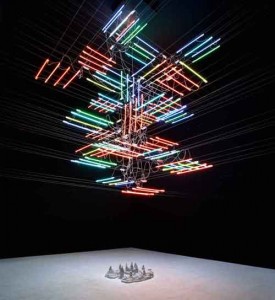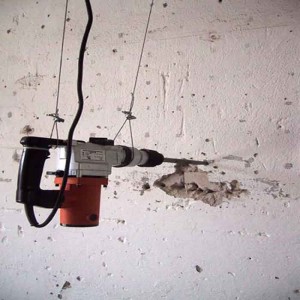The journey continues south west to…It’s Simply Beautiful, LABoral, Gijón, Spain
The regions of northern Spain are all things between heaven and hell – magnificent pristine and secluded seascapes; hideous industrial and apartment monstrosities; family cafes serving generous daily staples of seafood and soccer; tanned tourists being photographed besides architectural styles varying from Romanesque to Gehry; loud late lunches of frothy cider and soft goat cheese; ripe figs hanging low on ancient gnarled trees; rhythmic influxes of chic luminaries of the art world; and the occasional Basque car bombing in Bilbao.
Located in Gijón, Asturias, LABoral Art and Industrial Creation Centre is the latest major player in the growing global engagement with the intersection of art, design and new technologies. This massive Spanish flagship media centre opened last March under the dynamic leadership of Rosina Gómez-Baeza, former Director of Arco Art Fair, and Chief Curator Austrian artist and engineer Erich Berger.
Housed in 12,400 square feet of a refurbished training centre (at a cost of 11 million Euro) originally built in the 1950’s under Franco’s regime for the children of the workers, LABoral’s vision is to stimulate interaction between the art world and the creative industries – creating an intellectual and cultural regeneration in the Austria’s region’s economy.
Taking a sophisticated curatorial approach to media art history, LABoral opened with two outstanding exhibitions, FEEDBACK and Gameworld, curated by international teams which included Christiane Paul (Whitney Museum), Jemima Rellie (Tate Gallery), Charlie Gere (New Media historian), Carl Goodman (Museum of the Moving Image) and Helen Stuckey (ACMI). Here half a century of art that uses electronic and digital technologies as a medium – Kinetic Art and Op Art, television and cinema, video games along with art that is responsive to input from its immediate environment or the Internet, are thematically grouped and branched to form a continuum of multi-faceted interwoven histories of our contemporary culture, and its industrial and academic creative ecology.
Their next show, It’s Simply Beautiful, showing a boarder diversity of poetics and practices, more painterly and installational than the normal program, contained a surprising discovery of Austarias talented light sculptor Carlos Coronas. For this show Coronas produced a large-scale neon light installation focusing in on the concept of utopia and beauty. In a discreet darkened space the matrix-like suspended neon creates a virtual reality space, future fantasy façade above an architectural model of an earthy city utopia.
Glowing ethereally, some neon tubes burnt out and irreplaceable for the duration of the exhibition, evoked a strange mix of passivity and menace reminiscent of TV antennas, Ariel advertising, security lasers, or a quietly buzzing hybrid life form feed by electrical cables. Not unlike the internet itself, the work hoovered both prettily and ominously in the cathedral ceilings of LABoral’s gallery space, making visable for me the electromagnetic soup we live in.
north east to…Opening, iMAL (interactive Media Art Lab) Brussels, Belgium
Onto another opening at iMAL’s Center for Digital Cultures and Technology in Brussels – a new venue dedicated to the contemporary artistic and cultural practices emerging from the fusion of computer, telecommunication, network and media. This exhibition examines space, control, privacy, boundaries and intervention into public spaces with many great responsive works curated by Yves Bernard – several of which had also been included in LABoral’s opening shows.
Particularly impressive is Walter Langelaar’s nOtbOt, with its conceptual and technical elegance combined with a sense of playful silliness. This self-playing videogame – well, really a mechanized joystick that has its robotic manoeuvres projected in real-time in front of it. The joystick is the player, trapped forever in an erratic but highly logical and semi intelligent feedback system generated by PD (Pure Data). Here human interaction becomes obsolete – you can try and manoeuvre in the game space, yet it is pointless as your actions only add to the chaotic feedback loop, creating a sense of dislocation and frustration in ones inability to enter into any engagement or control of the QuakeIII space.
In this age of regeneration, recycling and remediation, Alerting Infrastructure! refers to earlier works that emphasize the critical relationship between temporal physical structures and the social impact their inhabitants have upon those structures. Chris Burden, for example, created both tangible evidence of cause and effect and evoked a sense of threat in physical space in his 1985 work Samson. Simple and direct in construction, the work only functioned via human interaction, that is when people entered the museum through a turnstile a mechanical structure of wooden beams was forced against the wall (theoretically) eventually leading to the room’s collapse.
Space can be collapsed in so many ways..
Emerging from another plane into the parallel universe of Manchester with Britain playing France in the World Cup Soccer semi-finals, and Eid al-Fitr (the joyous three-day celebration of Fast-Breaking) marking the end of Ramadan, boys in shiny convertibles and girls with intricately hennaed hands, have taken over the street known as Curry Mile.
My knowledge of Manchester has mostly been informed by the movie 24 Hour Party People that documented the rise and fall of Tony Wilson, founder and manager of The Haçienda nightclub, and one of the five co-founders of Factory records. Wilson was a known as Mr Manchester for his work in promoting Manchester’s cultural status throughout his career and died in August 2007 amid a scandal that he could not receive National Health Service subsidy for his £3,500 per month cancer drugs. Making history, not money is a sad fact for many great cultural contributors from Van Gough to Kathy Acker.
It was at this point I had a tech melt down – loosing all of my PDA data and, unbelievably, the broadband in my hotel failed and would not be fixed for days, so my comfortable home base becomes the welcome familiarity of free wi-fi at Cornerhouse café, where the Outside The Box exhibition coincides with the Urban Screens Conference.
This tech black hole is quite ironic in Manchester being the heartland of technological developments such as the Flying Shuttle (developed by John Kay in 1733) one of the key inventions in weaving that helped fuel the Industrial Revolution. Ford Madox Brown’s mural John Kay, Inventor of the Fly Shuttle A.D. 1753 in the Great Hall of the neo-Gothic masterpiece Manchester Town Hall is a must see for anyone interested in the history of technology, as it depicts luddites destroying the shuttle mechanism while Kay is being smuggled to safety.
Despite the early Luddite battles, Mancunian’s continued on their technological quests and 60 years ago “Baby” – the world’s first computer that could both store AND process data, was developed with the help of Alan Turing. Back upstairs in the Cornerhouse Gallery I am mesmerised, as always, by the LED-based work of Jim Campbell, which clearly exemplifies the intertwining of art and technological development. As both an accomplished artist and Silicon Valley engineer Campbell pushes display mediums in ways that they were never designed to go. His small scale programmed red LEDs depict the intimacy and intricies of human movements in a eerily comforting machine produced vision.
Curated by Kathy Rae Huffman, Outside the Box celebrates artists who have innovative approaches to screen-based work in public spaces – creating unexpected shifts in perception, and moving away from entrenched, predictable ways of working. Significantly the exhibition includes the first reconstruction of Hole In Space – a historic, pre-internet, real time public screen broadcast from one coast of the USA to the other.
Artists Kit Galloway and Sherrie Rabinowitz who devised Hole In Space, set up screens anonymously inside shop fronts, at the Lincoln Centre for Performing Arts in New York and at Century City in Los Angeles. There were no signs – just life-size, head to toe projections staring at each other, through two large screens, enabled by some nifty satellite technology. Masses gathered at both locations over three nights and the vast distance between people and cities was instantly bridged, setting up precents for today’s social networking. This groundbreaking public communication sculpture was recreated in Cornerhouse using the original footage, enabling viewers to stand between the screens being simultaneously in LA or NY, and theoretically in the ethereal/network the space in-between.
In 1980 public screens were virtually non-existent, making Hole in Space an intriguing spectacle akin to today’s virtual space interfaces, giving The Gate project this emergent position. Back in the outside world, the proliferation of public displays such as LED, LCD, plasma screens, large-scale projections and media facades demand a critical reflection of their impact. While mostly commercial they can also provide opportunities for artists and community, placing playful and non-commercial content in public space.
Urban Screens in Manchester looked specifically at the creation of content, commissioning and funding issues, and curatorship of public screens, with screenings and interactive works through the city. Potential architectural possibilities for urban screens in the 21st century is astounding – especially given already existing projects in Germany and South Korea.
Currently the planet’s biggest single screen – 500m long, consisting of 12.5 million LED modules and a 550,000-watt sound system – towers 30m over Fremont Street pedestrian mall in Las Vegas. Thats a lot of space to work with, as artists including Jennifer Steinkamp have already found out. Attracting 17 million viewers a year it stacks up pretty well against web page hits or viewers thru gallery turnstiles or doors!
Melinda Rackham
Melinda was the Executive Director at ANAT from 2005 to 2009.
Read More
http://www.laboralcentrodearte.org/









